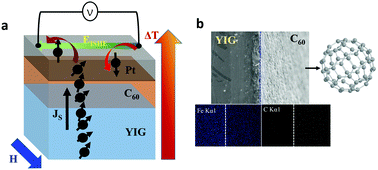Giant spin Seebeck effect through an interface organic semiconductor†
Abstract
Interfacing an organic semiconductor C60 with a non-magnetic metallic thin film (Cu or Pt) has created a novel heterostructure that is ferromagnetic at ambient temperature, while its interface with a magnetic metal (Fe or Co) can tune the anisotropic magnetic surface property of the material. Here, we demonstrate that sandwiching C60 in between a magnetic insulator (Y3Fe5O12:YIG) and a non-magnetic, strong spin–orbit metal (Pt) promotes highly efficient spin current transport via the thermally driven spin Seebeck effect (SSE). Experiments and first principles calculations consistently show that the presence of C60 reduces significantly the conductivity mismatch between YIG and Pt and the surface perpendicular magnetic anisotropy of YIG, giving rise to enhanced spin mixing conductance across YIG/C60/Pt interfaces. As a result, a 600% increase in the SSE voltage (VLSSE) has been realized in YIG/C60/Pt relative to YIG/Pt. Temperature-dependent SSE voltage measurements on YIG/C60/Pt with varying C60 layer thicknesses also show an exponential increase in VLSSE at low temperatures below 200 K, resembling the temperature evolution of spin diffusion length of C60. Our study emphasizes the important roles of the magnetic anisotropy and the spin diffusion length of the intermediate layer in the SSE in YIG/C60/Pt structures, providing a new pathway for developing novel spin-caloric materials.



 Please wait while we load your content...
Please wait while we load your content...